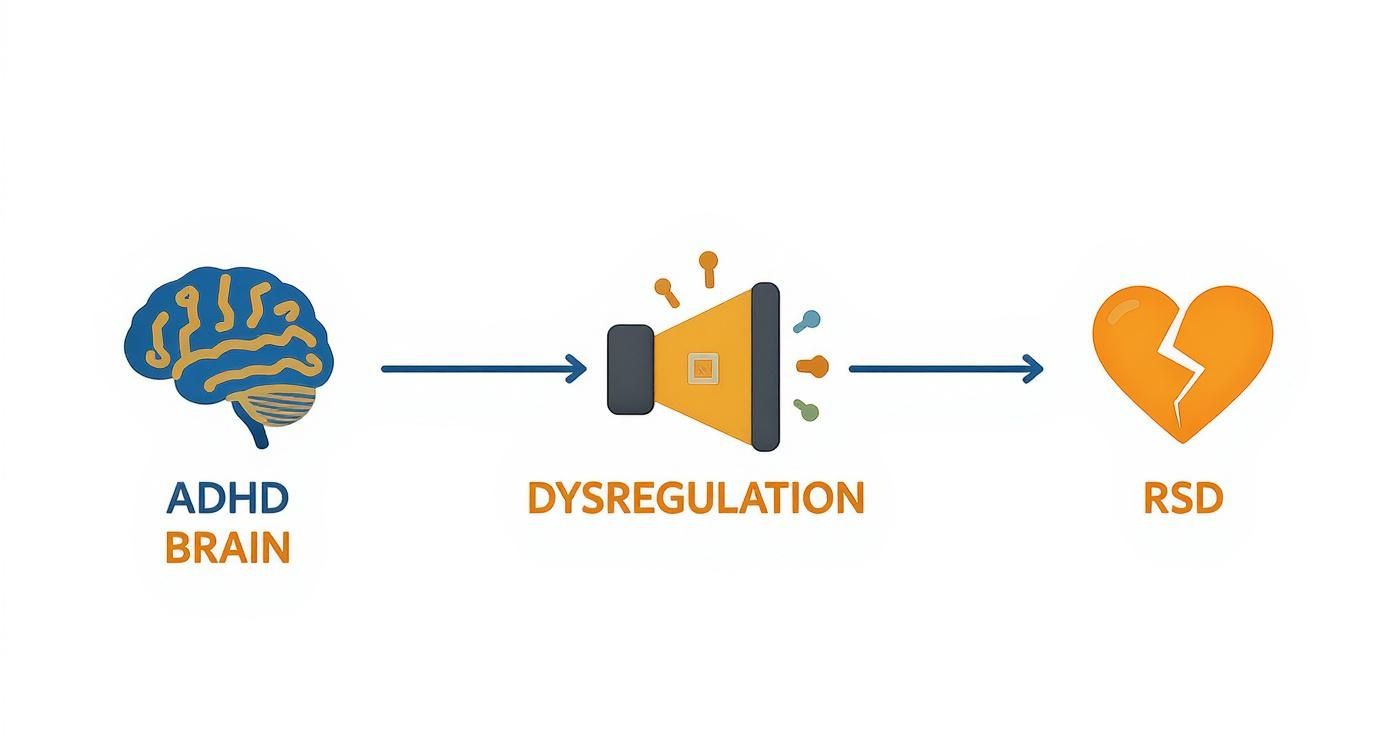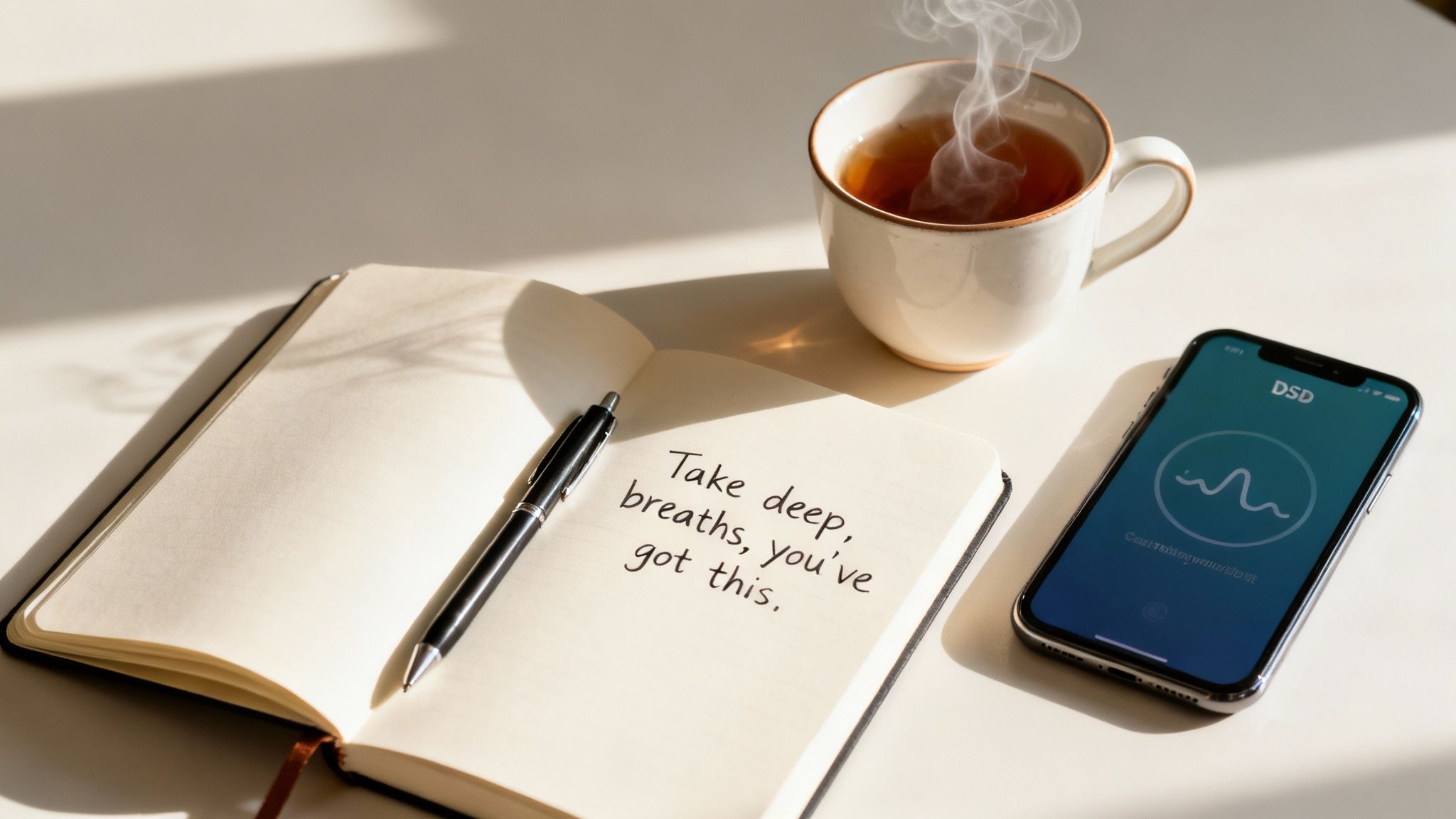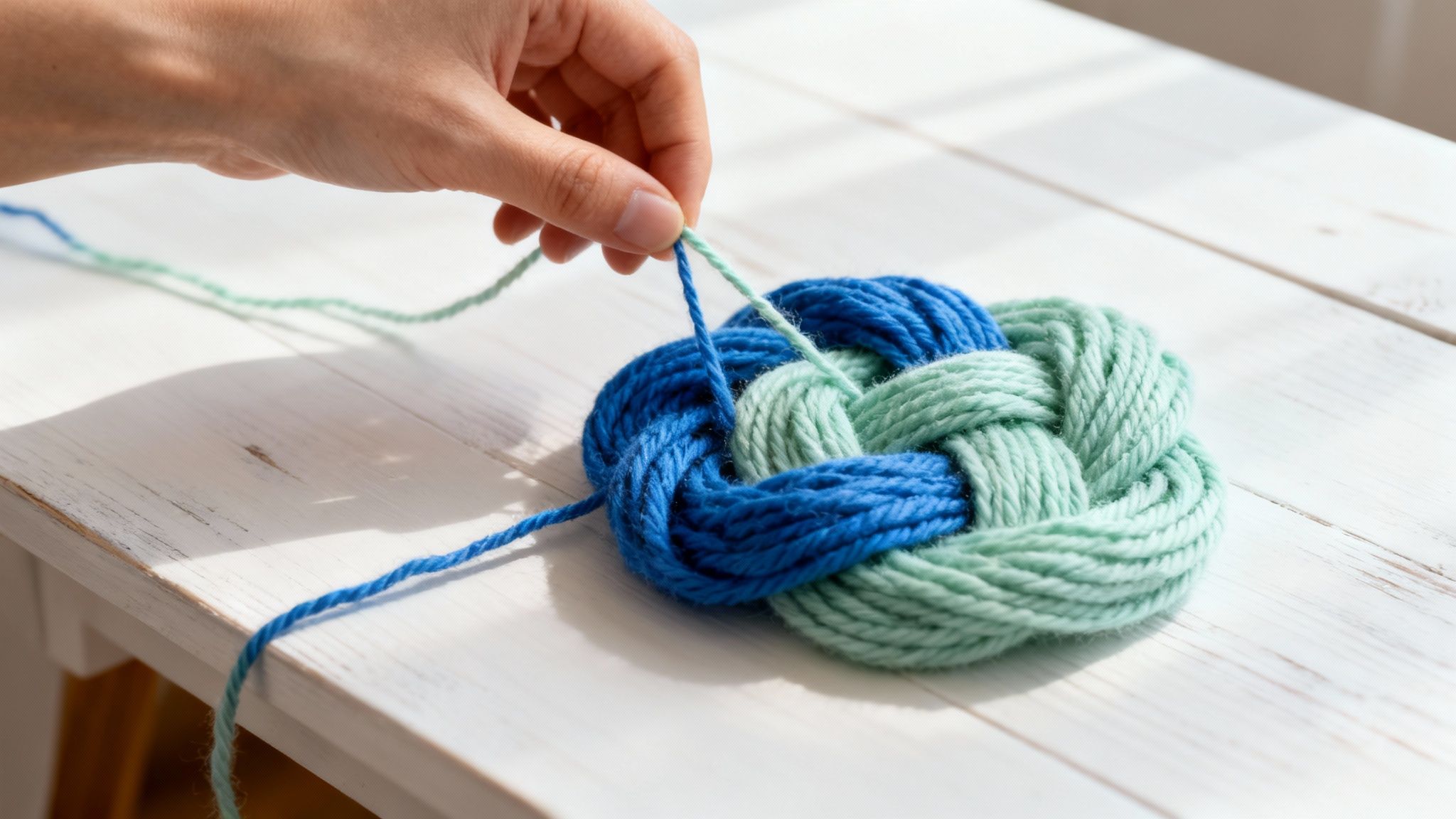Rejection Sensitive Dysphoria (RSD) is a tough one to explain, but if you've felt it, you know. It’s that crushing emotional sensitivity and pain that flares up when you simply think you’ve been rejected, criticized, or have failed.
It’s not just feeling let down. It's a profound, almost physical reaction that goes way beyond normal disappointment. For so many people, finally learning about RSD feels like finding the missing piece of a puzzle they’ve been working on their whole lives.
The Overwhelming Pain of Feeling Rejected

Have you ever sent a text and, seeing those little dots disappear with no reply, felt a sudden, sickening drop in your stomach? Your mind might immediately jump to, “They hate me. I said something stupid. I’ve wrecked everything.”
For many people, that’s a fleeting worry they can shake off. But if this pattern is familiar to you, that thought can instantly spiral into an overwhelming wave of emotional pain that feels just as real as a broken bone.
This isn’t just “being too sensitive.” It’s a distinct and incredibly intense experience, and these patterns are common among people with ADHD. When you live with RSD, even the hint of rejection can feel catastrophic.
What Is Rejection Sensitive Dysphoria?
So, what exactly is Rejection Sensitive Dysphoria? The term describes an intense, painful, and often unbearable emotional response to rejection, whether it's real or just perceived.
The word “dysphoria” comes from the Greek for “hard to bear,” which nails the experience perfectly. It’s an emotional gut punch.
This isn't about feeling a little sad or embarrassed. RSD can unleash a cascade of powerful emotions that are completely out of proportion to whatever actually happened.
💡 RSD is an instantaneous reaction, not a long-term worry. It’s the sudden, sharp emotional agony that hits the moment you perceive rejection—not the background anxiety about what people might think of you down the road.
This super-charged response can be triggered by things that might seem minor to others:
- A friend canceling plans last minute.
- Getting some constructive feedback at work.
- Feeling like you’re being ignored in a group chat.
- Not getting a “like” on a social media post you were proud of.
In these moments, your brain can interpret the situation as a major threat, flooding your system with immediate and overwhelming emotion. This often leads straight into a shame spiral. Understanding the patterns behind ADHD shame spirals can be a hugely validating first step in getting a handle on this.
Why the Pain Feels So Real
The pain of RSD isn't just in your head. While it’s not an official diagnosis in the DSM-5, it’s a concept that clinicians who work with ADHD know all too well. It’s thought to be tied directly to emotional dysregulation—a core, but often overlooked, feature of the ADHD brain.
Your nervous system essentially goes into overdrive, reacting as if you’re in genuine danger. This is not a character flaw or a sign of weakness; it’s a neurological response.
The feeling of rejection can be so intense that it completely derails your day, making it impossible to focus on anything else.
Just recognizing this pattern is a huge first step. Have you noticed this intense reaction in your own life? Understanding that this is a shared, brain-based experience is a powerful tool for self-compassion and can help you start finding strategies that work.
So, What’s the Link Between ADHD and RSD?
Ever wondered why rejection feels so catastrophic? If you have ADHD, this isn't about being weak or lacking resilience; it's a reaction deeply rooted in the very wiring of your brain. Think of it less like a character flaw and more like a neurological reflex.
At the heart of this connection is emotional dysregulation, a core feature of ADHD that often flies under the radar. Imagine the ADHD brain has a volume dial for emotions. Well, that dial is often cranked way up, and the controller is a bit glitchy. This can make it a real struggle to modulate feelings, which means emotional responses can come on faster, feel bigger, and are much harder to dial back down.
What this means in real life is that a tiny spark of perceived criticism doesn't just create a little puff of smoke. For someone with RSD, it can feel like an instant emotional wildfire.
The Brain's Emotional Amplifier
This intense reaction comes down to how the ADHD nervous system processes information. For many people, keeping emotions in check is almost automatic. But for those with ADHD, it’s a manual, exhausting process. The brain's executive functions, which are supposed to act as a filter and manager for our feelings, are often underactive.
Without that built-in filter, the raw, unfiltered pain of rejection can hit with its full force. It’s an immediate, overwhelming wave that completely bypasses rational thought, leaving you drowning in the emotional aftermath. Recognizing the signs of emotional dysregulation in ADHD is a huge first step in making sense of this powerful connection.
🔬 This isn't just a feeling; it's a physiological event. The sudden flood of stress hormones can trigger a fight-or-flight response, making the experience feel as threatening as a physical danger.
Learned Sensitivity Over Time
On top of the brain wiring, a lifetime of experience can pour gasoline on the fire. Navigating the world with ADHD often means a long history of moments where you felt "out of sync" or "not good enough."
- Years of hearing "just try harder" or "pay attention."
- Constantly struggling with deadlines or social cues that seem effortless for others.
- Internalizing that criticism until you feel like you're always falling short.
This history can create a learned hypervigilance to rejection. Your brain becomes conditioned to expect it, making you incredibly sensitive to any potential sign of disapproval. It’s a biological predisposition layered with years of painful lived experience.
While rejection sensitivity can pop up in other conditions, some clinical estimates suggest that a very high percentage of adults with ADHD experience it. It seems to hit harder in ADHD, largely because of that underlying emotional dysregulation.
Given this powerful link, it's worth exploring resources that offer real support. Many people find it incredibly validating when understanding the challenges of ADHD and how counselling can help. Just knowing the "why" behind these intense feelings is the first step toward self-compassion and figuring out what works for you.
How RSD Shows Up in Your Daily Life
Knowing the neurology behind Rejection Sensitive Dysphoria is one thing, but seeing how it actually plays out in real life? That’s when it all starts to click. RSD isn't some abstract concept; it’s a powerful force that can quietly shape your work interactions, put a strain on your friendships, and make relationships feel like walking on a tightrope.
When that emotional storm hits, it usually triggers one of two very different, yet equally painful, reactions. You might see yourself in one of these patterns—or maybe even both, depending on the day and the situation.

This diagram breaks down how the ADHD brain’s natural tendency toward dysregulation can crank up the volume on emotional responses, leading to that trademark intensity of RSD. It's a journey from a neurological difference to a deeply felt emotional reality—proof that this isn't a character flaw, but a brain-based response.
The Internalizer Pattern
Do you ever feel like you're your own worst critic? The internalizer takes that overwhelming pain of RSD and turns it inward. This pattern is all about intense self-criticism and a desperate need to keep everyone happy.
If you’re an internalizer, some of this might sound familiar:
- You become a people-pleaser: You'll bend over backward to make sure everyone is happy, secretly hoping that if you're just perfect, you'll never have to face disapproval.
- You avoid risks at all costs: That fear of failure is so paralyzing that you stay quiet in meetings, shy away from new hobbies, or even hesitate to reach out to new friends.
- You overthink the smallest interactions: A short, one-word text can send you into an anxiety spiral, replaying the conversation on a loop to figure out what you must have done wrong.
- You instantly take the blame: Even when something is clearly not your fault, your first instinct is to apologize and take responsibility, just to defuse any hint of conflict.
Trying to preempt rejection 24/7 is completely exhausting. It can leave you feeling isolated, drained, and like you can never truly be yourself.
The Externalizer Pattern
For others, that intense RSD pain is just too much to hold inside. The externalizer pattern is about projecting that hurt outward, often in a sudden burst of anger or defensiveness.
This doesn't mean you're an "angry person." It's a defense mechanism—a way to shove the source of the pain away before it can totally overwhelm you.
💡 The anger is often a mask for profound hurt. It’s a reflexive attempt to protect yourself from what feels like an unbearable emotional attack. Think of it like a cornered animal lashing out—it's driven by fear, not aggression.
An externalizer might suddenly snap at a partner over a minor comment that felt like a jab, or impulsively quit a project after getting some constructive feedback. The emotional reaction is swift and fierce, often leaving everyone confused and hurt once the dust settles.
Living with RSD can have a huge impact. In fact, some people report that the emotional pain is more impairing than the classic ADHD symptoms we hear about. Some research suggests that around one-third of adults with ADHD point to RSD as their single most debilitating challenge, with some studies finding that women with ADHD reported RSD symptoms more often than men, showing just how different these experiences can be.
Just recognizing these patterns in your own life is a huge, validating first step. It helps shift the narrative from "What's wrong with me?" to "How can I support my brain's unique wiring?" With that awareness, you can start exploring tools and strategies to manage these intense reactions—a journey that Inflow is here to help guide.
Building Your Toolkit for Managing RSD

Alright, getting a handle on why RSD happens is a massive step. Now, let’s pivot from the problem to the solutions—the practical, compassionate things you can actually start doing today.
Managing RSD isn't about trying to surgically remove your sensitivity. Think of it more like building a toolkit to help you navigate those intense emotional waves without getting completely swept away. It’s about creating a sense of safety from the inside out, so a single comment doesn't have the power to ruin your whole day.
With practice and support, you can learn to respond to triggers with intention instead of just reacting on autopilot.
Challenging Your Automatic Thoughts
One of the most powerful tools you can add to your kit is the ability to hit the pause button and question the stories your brain tells you in the heat of an RSD moment. Our minds are wired to leap to the worst-possible conclusion, but those first thoughts are often distorted and not based in reality.
This is where cognitive reframing comes in. It's the simple act of catching a painful thought, looking for the real evidence for and against it, and then crafting a more balanced, realistic perspective. If you want to go deeper on this, our guide to Cognitive Behavioral Therapy for ADHD is a fantastic resource.
Imagine you're a detective investigating your own thoughts.
- The Trigger: A coworker gives you some brief, direct feedback on a project.
- The RSD Thought: “They think I’m incompetent. I’ve completely failed.”
- The Reframe: “Their feedback was about the task, not my worth as a person. They’re direct with everyone, and it helps us produce better work.”
Creating a Calming Pause with Mindfulness
When an RSD trigger hits, your nervous system can go from zero to sixty in a split second. Mindfulness is your secret weapon for creating a tiny pocket of space between that trigger and your emotional reaction. That little pause is everything—it gives you a chance to breathe and choose your response.
You don't need to meditate for hours on a cushion. It can be as simple as taking three deep, slow breaths the moment you feel that familiar pang of hurt.
💡 The goal of mindfulness isn't to stop the feeling, but to observe it without judgment. Acknowledge the pain by saying to yourself, "This hurts right now," which can be incredibly validating. This simple act of naming the emotion can dial down its intensity.
This practice helps quiet your body's alarm system, allowing the more rational part of your brain to come back online.
Improving Communication and Setting Boundaries
Let's be real: fear of rejection can make it feel impossible to state your needs or hear feedback without bracing for impact. Learning a few simple communication scripts can be a game-changer, helping you advocate for yourself while feeling more secure.
✅ When receiving feedback: Instead of tensing up for criticism, try saying, “Thank you for letting me know. I’ll take some time to think about that.” This buys you time to process without reacting in the moment.
✅ When expressing a need: Use “I” statements to keep the focus on your experience. For example, “I feel a bit disconnected when plans change at the last minute. Could we try to give each other a heads-up?”
Building these skills takes time and consistent practice.
Finding Professional and Personal Support
Trying to deal with the intense emotional storm of Rejection Sensitive Dysphoria can feel profoundly lonely. But here’s the thing: you absolutely don’t have to go through it alone.
Building a solid support system is one of the most powerful things you can do. This means finding the right professional help and, just as importantly, learning how to let the people who care about you into your world with a bit more empathy and understanding.
Think of it like this: you wouldn't hesitate to see a specialist for a physical injury. The same logic applies here. Working with a mental health professional provides a clear, structured path toward feeling better. Therapies like Cognitive Behavioral Therapy (CBT) and Dialectical Behavior Therapy (DBT) are especially helpful.
And no, these aren't just about "talking through your feelings." They're about learning concrete skills to manage that emotional intensity.
Therapeutic Approaches and Medication
Therapy gives you a practical toolkit to start untangling that lightning-fast connection between a trigger and your reaction.
- Cognitive Behavioral Therapy (CBT) is all about identifying and challenging the automatic negative thoughts that kickstart an RSD spiral. It teaches you to be a detective of your own mind, questioning beliefs like, "They definitely think I'm a failure," and swapping them out for more realistic perspectives.
- Dialectical Behavior Therapy (DBT) offers a powerhouse of skills for mindfulness, tolerating distress, and regulating emotions. DBT helps you learn to sit with those really uncomfortable feelings without getting completely swept away, creating that crucial pause before you react.
For many people with ADHD, medication also plays a huge part. While it's not a direct "cure" for RSD, medications that help regulate dopamine and norepinephrine can improve overall emotional stability and executive function. By turning down the volume on other ADHD symptoms, it becomes so much easier to actually use the skills you’re learning in therapy.
If you’re wondering where to even start with all that, our guide on who evaluates, diagnoses, and treats adult ADHD can help clear up the process.
Finding the right mix of support is a deeply personal journey. The goal is to build a foundation of stability that makes the emotional highs and lows of RSD feel less like a tidal wave and more like a current you know how to navigate.
How to Talk About RSD with Loved Ones
Opening up about RSD can feel incredibly vulnerable, but it’s the single best way to get the support you actually need. People can't understand what they don't know.
Start simple. You could try saying something like, “You know how sometimes I seem to have a really strong reaction to small things? There’s a name for that. It’s called RSD, and for my ADHD brain, feeling criticized or rejected can be incredibly painful—almost like a physical injury.”
Using an analogy often helps. You could explain that your emotional "alarm system" is just wired to be extra sensitive. This simple shift can change the conversation from one of blame to one of understanding.
Got Questions About RSD? Let's Clear a Few Things Up.
Diving into the world of Rejection Sensitive Dysphoria can feel like a lightbulb finally turning on. It’s a concept that hits home for so many people, yet there’s still a ton of confusion floating around. Let's tackle some of the most common questions and bust a few myths.
Think of this as your personal clarity session. It’s all part of figuring out how your unique brain is wired and how to give it the support it deserves.
So, Is RSD Just Another Name for Social Anxiety?
This is probably the biggest point of confusion, and for good reason—on the surface, they can look almost identical. Both can make social situations feel like you’re trying to navigate a minefield blindfolded. But when you dig a little deeper, you find their roots are in totally different places.
Social anxiety is usually a persistent, forward-looking fear. It’s that chronic, nagging worry about future social events and the dread of being judged when you get there.
RSD, on the other hand, is a sudden, intensely painful emotional reaction to rejection or criticism that you feel is happening right now. It’s less of a slow-burning worry and more of a spontaneous emotional gut punch.
💡 The key difference is all about timing. Social anxiety is the dread of what might happen. RSD is the overwhelming pain of what you believe is happening in this very instant.
Can You "Cure" Rejection Sensitive Dysphoria?
It's tempting to look for a cure, but RSD isn't really a "disease" that can be wiped out. A more helpful way to think about it is as a neurobiological trait that you can learn to manage—really, really well. The goal isn't to erase your sensitivity but to learn how to navigate it without the overwhelming pain that throws your life off course.
For a great foundational overview of the condition, you can dive deeper into Rejection Sensitive Dysphoria and its core components.
With the right combination of strategies, you can dial down its impact in a huge way:
- Understanding your triggers. Getting to know what sets off your RSD is half the battle.
- Building coping skills. Therapy approaches like CBT (Cognitive Behavioral Therapy) or DBT (Dialectical Behavior Therapy) are amazing for this.
- Professional support. Working with a professional to see if ADHD medication could help improve your overall emotional stability is a common path.
- Self-compassion. This isn't just fluffy stuff; it's a powerful tool for calming the storm.
How Can I Support a Partner or Friend with RSD?
Supporting someone with RSD starts with two things: empathy and a real willingness to understand what they're going through. Honestly, one of the most powerful things you can do is just validate their feelings without trying to fix or dismiss them.
Try phrases like, “That sounds incredibly painful,” or “I can totally see why that would hurt so much.” That simple act of validation can defuse the emotional intensity in a major way.
Ambiguity is a huge trigger for RSD, so practicing clear, kind, and direct communication is also a game-changer. After a disagreement, taking a moment to reassure them of your care and commitment can make all the difference in the world.








